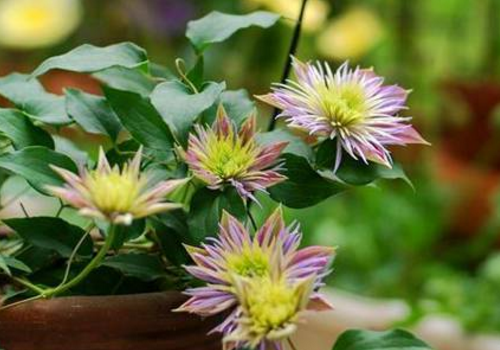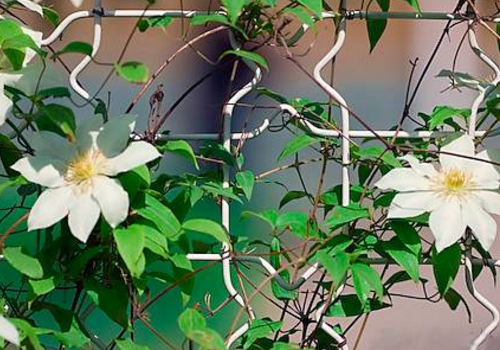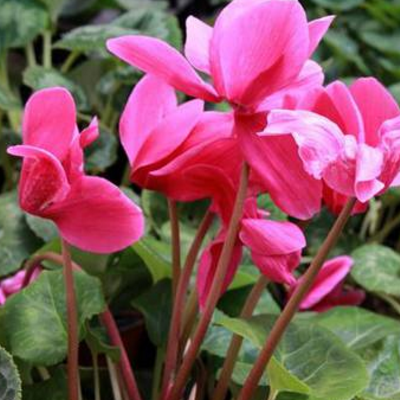Culture methods and matters needing attention of Clematis how to wither
Clematis flowers and colors of many people, so it is more suitable for family ornamental plants, so clematis culture methods and points for attention? What if it withered?
Culture methods and matters needing attention of clematis:
1. Clematis soil requirements
Like fertile, well-drained alkaline loam, avoid stagnant water. The most important thing is that the basin soil must be breathable, if possible, choose some better soil, after strict disinfection, poor conditions can use perlite and peat, try not to dig garden soil pot.
2. Watering requirements of clematis
Clematis growing well requires smooth root breathing and alternating wet and dry watering. To let the basin soil dry time, generally 2-3 cm below the soil surface dry, can be watered. If it is a plastic basin, it is another matter. According to the weight of the basin soil, it should be watered if it becomes lighter; if you observe the basin soil, if you look at the basin soil, you need to water it. Watering must be thoroughly watered. The concept of watering thoroughly is at least water flowing out from the bottom of the basin. Pay attention to timely ventilation after watering.
3. Lighting requirements of clematis.
Potted clematis were cultivated in full light from autumn to early spring of the next year, without shade. Strong light after entering summer will lead to aging and yellowing of clematis leaves, poor growth, and need proper shading. In indoor maintenance, it is necessary to ensure at least 4 hours of sunlight every day, otherwise clematis will not grow well.
4. Fertilization methods of clematis.
Adhere to the application of thin fertilizer frequently, avoid eager for quick success and quick profit. There are many varieties of clematis, some of which are not fertilizer-tolerant, such as long petals, evergreen, Montana, and should be less fertile when maintained. In addition, when applying fertilizer to young seedlings, it is best to use only promoting root and slow seedling fertilizer, not heavy fertilizer. Winter is the best season for clematis to apply fertilizer, basically once, manage for a few months!
5. Matters needing attention in clematis culture.
Newly planted clematis need to pay attention to sufficient water in the first few months, so that the roots have enough water to extend.
Clematis is a vine whose branches are brittle and easy to break, so pay attention to timely inducement and fixation.
Clematis cultured on the open-air balcony should pay attention to timely drainage, especially in the rainy season, can properly accept the rain, but not excessive, move to the indoor at the right time.

What if clematis wilt:
1. The cause of Clematis wilt
1. Fusarium wilt is mostly caused by moist air and molds invading branches.
Therefore, in the rainy, wet and warm spring, Fusarium wilt will be more frequent. Especially in the sunny weather after the heavy rain. In fact, the withering point has been produced earlier, because of the rain, the branches are not short of water, but also maintain the illusion of health. When the sun came out, the branches were suddenly short of water, and the top twigs drooped.
2. Fusarium wilt is difficult to detect in advance, and every branch is not checked point by point every day.
However, take some preventive measures as far as possible in the planting process, although it can not be absolutely avoided, it can still reduce some of the probability.
2. Treatment of withered branches of Clematis clematis
Although Fusarium wilt is common, it is generally not fatal. If only one or two branches wither, the treatment is to prune the withered branches from the blackspots, which will have no effect on other healthy branches. If the whole plant is withered, only the roots are retained after all pruning, and new branches may grow again in autumn.
In fact, the withered branches do not need to be discarded, if found in time, cut off the top shoots with buds, retain some of the semi-lignified branches, put them in the water for a while, the leaves come alive and can be used for cutting.
3. prevention of Fusarium wilt of Clematis clematis
Organic fertilizer applied in winter should not come out at the root node as far as possible, otherwise, incompletely fermented organic fertilizer is very easy to produce mold; carbendazim can be used in early spring Fusarium wilt season, watering or spraying.
Strengthen ventilation and reduce the production of mold.
There is the most important point, everyone is to choose a formal florist as far as possible, and before buying, you must understand your needs and buy back a pot of clematis that suits you.
All right, guys, you all know what happens when clematis wither.
Culture methods and matters needing attention of Clematis
Clematis culture method, clematis is born in hilly shrubs in low mountain areas. Like fertile, well-drained alkaline loam, avoid stagnant water or summer drought and can not retain water. Strong cold resistance, can withstand-20 low temperature. If there are red spiders or leaf-eating pests, ventilation should be strengthened. Clematis is rich in color, with a light fragrance, great ornamental value, loved by many people, the clematis culture methods and matters needing attention.
Culture method of Clematis 1. Watering
Clematis is very sensitive to moisture and should not be too wet or too wet, especially in the summer high temperature period, the matrix should not be too wet. Generally, it is watered every 3-4 days during the growing period, when the substrate is dry but the plant does not wilt. During the dormant period, as long as you keep the matrix moist. Do not let water accumulate on the leaf surface or at the base of the plant when watering, otherwise it is easy to cause disease.
2. Temperature
The optimum temperature for clematis growth was 15: 17 ℃ at night and 21: 25 ℃ at day. When the summer temperature is higher than 35 ℃, it will cause clematis leaves yellowing and even falling leaves, so cooling measures should be taken in summer. In November, the temperature continues to drop, and clematis will enter a dormant period when it is below 5 ℃. In December, Clematis completely entered the dormant period, and the leaves began to fall in the first and second weeks of the dormant period.
3. Pruning
The purpose of Clematis clematis pruning is to open more flowers, usually once a year, to remove some overdense or thin branches, and to make the new branches extend in all directions. The time of pruning should be determined according to the flowering period of different varieties. Early flowering varieties (flowering from April to May) should be pruned after flowering, that is, from June to July, to remove the excess branches, but the Lignified branches should not be cut off. If pruning before then, it will lead to the failure of flowering in the same year.
4. Lighting
Clematis requires more than 6 hours of direct light a day, which is very beneficial to its growth, although spots can occur in hot weather. Potted clematis is cultivated under full light from autumn to early spring of the next year without shade. After entering summer, it is necessary to prevent strong direct light and appropriate shade. Otherwise, it is easy to cause the leaves of clematis to be aged, withered and yellow and grow poorly.
5. Fertilization
Before sprouting new buds in late February or early March, clematis can apply a little compound fertilizer with a npk ratio of 15:5:5 to accelerate growth, and topdressing phosphate fertilizer once in April or June to promote flowering. Usually use 150mg / kg 20:20:20 or 20:10:20 water-soluble fertilizer, in the growth period to 200mg / kg, spray 2 times 3 times a month.
Reproduction method
A, sowing: the original seed of Clematis can be propagated by sowing, germinate after sowing in spring for about 3-4 weeks, and germinate in autumn when spring is warm.
B, pressing: clematis is propagated in March with one-year-old mature branches, usually rooting within one year.
C, ramet: clematis tufted plants, can be ramified.
D. Cutting: cutting is the main propagation method for hybrid clematis cultivars.
Matters needing attention in clematis culture
1. Clematis in poorly drained clay or light sandy soil, mix-shovel peat soil or humus after digging loose at the bottom of the hole, and use stones or rubble at the bottom where water may accumulate, 25 cm higher than the surrounding soil surface.
2. Pay attention to adequate water supply in the first few months after clematis planting, and the diameter of the water supply range is not less than 50 cm, so that the root can stretch around, and special attention should be paid to drainage at the same time.
3. Clematis pest is harmed by red spider and diamondback moth, which is sprayed with 1000 times of fenitrothion EC.
4. When clematis is planted, the hole is generally 40 cm deep and 60 cm in diameter. After loosening the hard soil at the bottom of the hole, a large amount of humus is put in, and then the topsoil mixed with bone powder is added. Note that the branches are brittle and easy to break, so attention should be paid to attraction and fixation.
5. The disease of clematis has Fusarium wilt, which is likely to occur on rainy days in summer, when the temperature rises sharply, the branches suddenly wither, and new techniques often sprout in autumn or the following spring. Others have powdery mildew, virus disease, etc., sprayed with 1000 times of acetic acid solution of 10% antibacterial agent.
Clematis value 1. Ornamental value
Clematis clematis branches and leaves are sparse, some flowers are large and colorful, some florets gather into large inflorescences, funny and unique, it is an indispensable good material in climbing greening, and has a certain ornamental value.
2. Beautify the household use
Clematis can be planted on the walls and windows of household buildings, or attached to trees and shrubs in the courtyard, planted between rockery and rocks, attached to styles, gates and fences, and can also be watched in potted plants. it is a good choice to beautify the home environment.
How to raise clematis? Culture methods and matters needing attention of Clematis
[FAQ] how to raise clematis?
[expert answer] Culture methods and matters needing attention of clematis:
1. Temperature: the optimum temperature for growth is 15: 17 ℃ at night and 21: 25 ℃ at day. In summer, when the temperature is higher than 35 ℃, it will cause clematis leaves yellowing or even falling leaves, so cooling measures should be taken in summer. In November, the temperature continued to drop, when the temperature was below 5 ℃, Clematis would enter the dormant period, in December, Clematis completely entered the dormant period, and in the 1st and 2nd week of dormancy, Clematis began to defoliate.
2. Light: clematis needs more than 6 hours of direct light every day, which is very beneficial to its growth, although spots will occur in hot weather.
3. Watering: clematis is very sensitive to water and should not be too wet or too wet, especially in the period of high temperature in summer, the matrix should not be too wet. Generally, water is watered every 3-4 days during the growing period, and watering is carried out when the substrate is dry but the plant does not wilt. During the dormant period, as long as you keep the matrix moist. Do not let water accumulate on the leaf surface or at the base of the plant when watering, otherwise it is easy to cause disease.
4. Fertilization: before sprouting new buds in late February or early March, a little compound fertilizer with a NPK ratio of 15:5:5 can be applied to accelerate growth, and phosphate fertilizer should be applied once in April or June to promote flowering. Usually use 150mg/kg 20:20:20 or 20:10:20 water-soluble fertilizer, in the growth period increased to 200mg/kg, spraying 2-3 times a month.
5. Pruning: the purpose of pruning is to plant more flowers. Pruning is usually done once a year to remove some overdense or thin branches so that the new branches can be extended in all directions. The time of pruning should be determined according to the flowering period of different varieties: early flowering varieties (flowering from April to May) should be pruned after flowering, that is, from June to July, to remove excess branches, but not Lignified branches. If pruning before then, it will lead to the failure of flowering in the same year.
6. pest control: Clematis has strong resistance to diseases and insect pests. The phenomenon of serious damage to diseases and insect pests rarely occurs. The disease is caused by Fusarium wilt, which is likely to clear up on rainy days in summer. when the temperature rises sharply, the branches suddenly wither, and new techniques often sprout in autumn or the following spring. Others have powdery mildew (harmful leaves or flowers), virus diseases (yellow spots in leaves, flower deformities), etc., sprayed with 1000 times of acetic acid solution of 10% antibacterial agent. Pests are harmful to red spiders and stinging moths, which are sprayed with 1000 times of 50% fenitrothion EC.
[editor's comments] there are many varieties of clematis, but most of them are deciduous or evergreen herbaceous vines, with the laudatory name of "Liana Flower Queen". Generally, they bloom from June to September, the flowers are white, and they can also be exhibited as ground covers. Root and whole grass are used as medicine, which are of many use. the above first Agricultural Classic Xiaobian introduced its breeding methods and some points for attention. I hope this article will be helpful to you.
- Prev

The difference between the breeding method of Clematis and Clematis
There are many propagation methods of clematis, which is a kind of plant with good growth, which is suitable for ornamental plant, so the propagation method of clematis? The difference between rotor lotus and rotor lotus? The propagation method of clematis: the cutting propagation method of clematis, and the cutting is the main propagation method of hybrid clematis.
- Next

Cyclamen, why do the flowers bloom and rot more and more?
Cyclamen is opened before and after the Spring Festival in Zi'an, and the bright red forehead color is very suitable for festive festivals, so go to understand why cyclamen flowers are getting lighter and lighter. What about cyclamen rotting roots? Why cyclamen flowers are getting lighter and lighter: the reasons why cyclamen color becomes lighter, 1. Lack of nutrition.
Related
- Fuxing push coffee new agricultural production and marketing class: lack of small-scale processing plants
- Jujube rice field leisure farm deep ploughing Yilan for five years to create a space for organic food and play
- Nongyu Farm-A trial of organic papaya for brave women with advanced technology
- Four points for attention in the prevention and control of diseases and insect pests of edible fungi
- How to add nutrient solution to Edible Fungi
- Is there any good way to control edible fungus mites?
- Open Inoculation Technology of Edible Fungi
- Is there any clever way to use fertilizer for edible fungus in winter?
- What agents are used to kill the pathogens of edible fungi in the mushroom shed?
- Rapid drying of Edible Fungi

